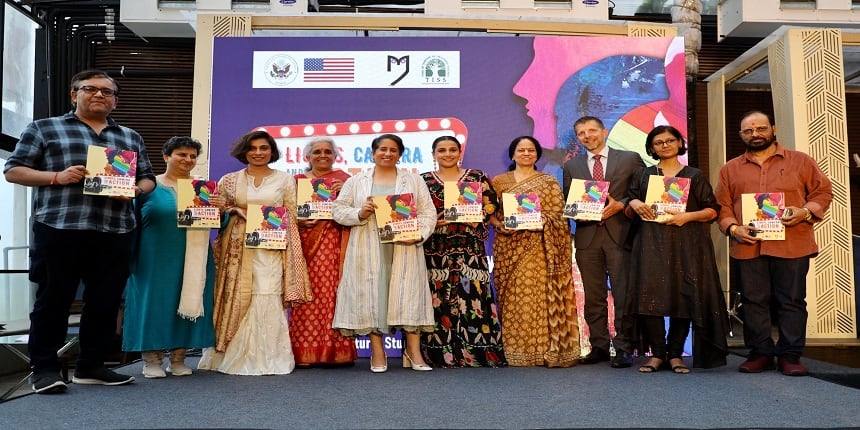TISS Mumbai study highlights gender bias in Bollywood, calls for equal representation of women in cinema
Arpita Das | June 29, 2023 | 03:22 PM IST | 3 mins read
The study found that women in films are often depicted in employment and public domain roles, but these roles tend to be gendered.

NEW DELHI: The Tata Institute of Social Sciences Mumbai has released the report, ‘Lights, Camera, and Time for Action: Recasting a Gender Equality Compliant Bollywood’ on June 28. The study reveals that on and off-screen women and queer representation in box-office hits remain largely stereotypical.
The research studies analysed 25 box-office hits of 2019 to capture a full year of pre-pandemic theatrical releases, as well as 10 ‘women-centric films released between 2012 and 2019 as a representative sample.
In the research, 15 crucial parameters such as intersectional representation, occupation, degree of sexual stereotyping, consent and intimacy and harassment were analysed. The studies also analysed women’s participation behind the scenes and off-screen.
Also Read | TISS SVE, Maharashtra state board partners for vocational education programmes
Vidya Balan, actor; Nandita Das, actor, filmmaker and social advocate; Guneet Monga Kapoor, film producer and academy award winner; Nitin Tej Ahuja, CEO Producers Guild of India and B N Tewari, President, FWICE, WIMPTSEA released the report.
Professor Shalini Bharat, director, TISS; Consul General Mike Hankey, US Consulate General, Mumbai and Professor Lakshmi Lingam, research study director were also present at the event.
TISS also carried out studies with the experiences and perspectives of women and queer screenwriters, directors, and young online media critics.
The main findings of the study include:
- 72% of characters in the analysed films are played by cis-males, 26% by cis-females, and 2% by queer actors.
- 36% of box office hits and 100% of women-centric films passed the Bechdel test.
- The most popular skin tone for women characters is fair skin and body type is thin for lead characters and medium for all other support characters.
- Expression of romance and intimacy is restricted in the box office and women-centric films, but most often it is male characters who initiate intimacy. The idea of consent is still fraught with ambiguity, precisely because there is a greater emphasis on women remaining demure and expressing consent through non-verbal and symbolic gestures.
- Women in employment and in public domain work are shown in films, however, the work roles they play are gendered, with a greater presence of women in health care, education, entertainment, and journalism.
- Women-centric films have greater diversity and explore inbound subjects dealing with relationships, sexuality, motherhood, and other sensitivities.
- Box-office hits have outbound subjects like war, politics, corruption, gang wars, and crime.
- The majority of characters in films are in the age group of 21-45 years and belong to Hindu dominant castes.
- People with disabilities are rarely seen in films. Only 0.5% of characters are shown with disabilities.
Sharing her thoughts on the findings, Vidya Balan stated, “When I read the report I was surprised because the ground reality seemed different to me. I don’t think we have creche facilities yet but definitely POSH committees have been instituted in every production that I have been involved in and I can say that a lot of production houses are following that. As far as more women in cinema goes, there has to be a holistic solution to it. I don’t see why it's a bad thing if women directors are hiring women technicians and women heavy crews . Eventually, that will percolate into male-led films also. I have seen that change with movies like Mission Mangal.”
Nandita Das adds, “This is a very important report that tells us where we are in terms of representation in Hindi films, both, in front and behind the camera. Anecdotally we may feel we are far better than where we were, but the research and statistics show us that we have a rather long way to go. It is a detailed and thought-through report that needs to be seen by anyone who cares to be part of the change that we want to see in the film industry. That’s why it’s rightfully called - Lights, Camera and time for action.”
Mike Hankey, US Consul Genera;, Mumbai, emphasized the importance of collaboration between Bollywood and Hollywood, as well as between India and the United States, in improving conditions for women. He highlighted that this effort extends beyond the realms of art and entertainment, holding significant implications for international relations.
Representatives of several film industry bodies, film professionals and media and communication students also attended the event.
Earlier, TISS shared interim findings of the study at marquee film festivals like the International Film Festival of India, Goa; Pune International Film Festival; International Association of Women in Radio and Television Film Festival, New Delhi; and the India Film Project, Mumbai.
Follow us for the latest education news on colleges and universities, admission, courses, exams, research, education policies, study abroad and more..
To get in touch, write to us at news@careers360.com.